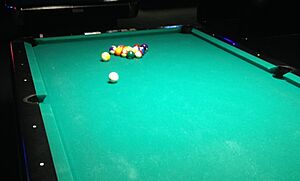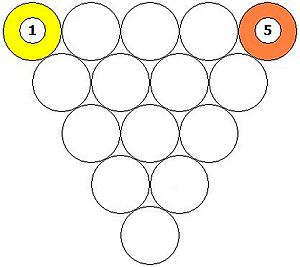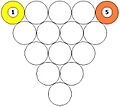Straight pool facts for kids
Straight pool, also known as 14.1 continuous, is a fun pool game. It used to be the main game played in championships. Later, faster games like nine-ball became more popular. But straight pool is a classic game with a long history in pool.
This game was very popular in the United States. It was even featured in a famous movie called The Hustler in 1961.
In straight pool, a player can try to sink any ball on the table. The main goal is to reach a certain number of points. Players agree on this score before the game starts. You get one point for each ball you sink legally (without breaking a rule). A typical game might need a player to score 100 points. This means you need to sink at least 100 balls to win! In professional games, players usually play to 150 points.
Straight pool is a "call-pocket" game. This means you must say which pocket you plan to sink the ball into before you shoot. It doesn't matter how the ball gets there. As long as it goes into the pocket you called and you don't break any rules, you score a point.
Straight pool is well-known in the United States, Europe, Japan, and the Philippines. However, it's not as common in other parts of the world. Willie Mosconi, who many consider the greatest player ever, holds the record for the highest "run" in this game. A "run" is how many balls a player can sink in a row without missing or fouling. He once sank 526 balls in a row!
Contents
How to Play Straight Pool
Starting the Game: The First Rack
To start straight pool, all fifteen colored balls are placed in a triangle shape. This is called a "rack." The ball at the very front of the rack sits on a special spot on the table called the "foot spot." Usually, the 1-ball goes in the right corner of the rack. The 5-ball goes in the left corner. All the other balls are placed randomly. They should all be touching each other. Some players like to put a striped ball at the very front. This is because the first shot, called the "break," is very important. A striped ball might be easier to hit precisely.
In most pool games, you try to sink a ball and spread the others on the break shot. But straight pool is different. On the first break, your goal is often to leave your opponent with a "safety." A safety means your opponent has no easy shot. This is because you have to "call" your shot even on the break. If you hit the balls hard and sink many, they don't count unless you called them into a specific pocket.
To make a legal break, you must do one of two things:
- Sink a ball into a pocket you called.
- Make sure the white cue ball and at least two other colored balls hit a rail (the side of the table).
If you don't do one of these, it's a "foul." A foul on the first break is a special penalty. You lose 2 points. Also, your opponent gets to choose. They can either play from where the balls stopped, or they can ask you to re-rack the balls and try the break again.
Fouls and Penalties
During the game, most other fouls cost you 1 point. This includes fouls that happen during "intragame racks," which we'll talk about next.
However, there's a big penalty for three fouls in a row! If you foul three times in a row, you lose 15 points. This is in addition to the 1 point you lose for each foul. So, if you foul three times in a row, you lose 1 point for the first foul, 1 point for the second, and then 16 points for the third (1 point for the foul plus 15 extra points). A foul on the very first break, even though it's 2 points, only counts as one foul towards this "three fouls in a row" rule.
Continuing the Game: Intragame Racks
"Intragame racks" are all the racks that happen after the very first one. Since straight pool is played to many points (like 100 or 150), you'll need to rack the balls many times. There are only 15 balls, so you can't score enough points from just one rack. The rules for these racks are a bit different from the first one.
An intragame rack happens when only the white cue ball and one colored ball are left on the table. At this point, if the cue ball and the last colored ball are not in the way, the 14 balls that were already sunk are racked again. This time, the top spot of the rack is left empty. The rack is placed so that if there were a ball there, its center would be on the table's foot spot.
Play then continues. The cue ball stays where it was. The single colored ball that was left on the table also stays where it was.
The name "14.1 continuous" comes from this racking method. It means 14 balls are racked, and 1 ball is left out. The player will usually try to sink the single colored ball. At the same time, they try to hit the cue ball into the 14 racked balls. This spreads them out so the player can keep sinking balls and continue their turn.
Sometimes, the cue ball or the last colored ball might be in the way of racking the 14 balls. Or they might be very close to the racking area. There are special rules for these situations. For example, if the last colored ball is in the racking area, it might be moved to the foot spot. If the cue ball is in the racking area, it might be moved to the "kitchen" (the area behind the head string, which is a line on the table). These rules make sure the game can keep going smoothly.
Images for kids





